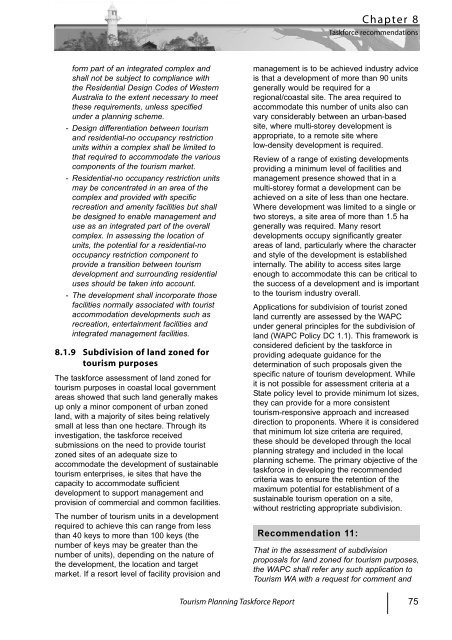Tourism Planning Taskforce Report - Western Australian Planning ...
Tourism Planning Taskforce Report - Western Australian Planning ...
Tourism Planning Taskforce Report - Western Australian Planning ...
- No tags were found...
You also want an ePaper? Increase the reach of your titles
YUMPU automatically turns print PDFs into web optimized ePapers that Google loves.
Chapter 8<strong>Taskforce</strong> recommendationsform part of an integrated complex andshall not be subject to compliance withthe Residential Design Codes of <strong>Western</strong>Australia to the extent necessary to meetthese requirements, unless specifiedunder a planning scheme.- Design differentiation between tourismand residential-no occupancy restrictionunits within a complex shall be limited tothat required to accommodate the variouscomponents of the tourism market.- Residential-no occupancy restriction unitsmay be concentrated in an area of thecomplex and provided with specificrecreation and amenity facilities but shallbe designed to enable management anduse as an integrated part of the overallcomplex. In assessing the location ofunits, the potential for a residential-nooccupancy restriction component toprovide a transition between tourismdevelopment and surrounding residentialuses should be taken into account.- The development shall incorporate thosefacilities normally associated with touristaccommodation developments such asrecreation, entertainment facilities andintegrated management facilities.8.1.9 Subdivision of land zoned fortourism purposesThe taskforce assessment of land zoned fortourism purposes in coastal local governmentareas showed that such land generally makesup only a minor component of urban zonedland, with a majority of sites being relativelysmall at less than one hectare. Through itsinvestigation, the taskforce receivedsubmissions on the need to provide touristzoned sites of an adequate size toaccommodate the development of sustainabletourism enterprises, ie sites that have thecapacity to accommodate sufficientdevelopment to support management andprovision of commercial and common facilities.The number of tourism units in a developmentrequired to achieve this can range from lessthan 40 keys to more than 100 keys (thenumber of keys may be greater than thenumber of units), depending on the nature ofthe development, the location and targetmarket. If a resort level of facility provision andmanagement is to be achieved industry adviceis that a development of more than 90 unitsgenerally would be required for aregional/coastal site. The area required toaccommodate this number of units also canvary considerably between an urban-basedsite, where multi-storey development isappropriate, to a remote site wherelow-density development is required.Review of a range of existing developmentsproviding a minimum level of facilities andmanagement presence showed that in amulti-storey format a development can beachieved on a site of less than one hectare.Where development was limited to a single ortwo storeys, a site area of more than 1.5 hagenerally was required. Many resortdevelopments occupy significantly greaterareas of land, particularly where the characterand style of the development is establishedinternally. The ability to access sites largeenough to accommodate this can be critical tothe success of a development and is importantto the tourism industry overall.Applications for subdivision of tourist zonedland currently are assessed by the WAPCunder general principles for the subdivision ofland (WAPC Policy DC 1.1). This framework isconsidered deficient by the taskforce inproviding adequate guidance for thedetermination of such proposals given thespecific nature of tourism development. Whileit is not possible for assessment criteria at aState policy level to provide minimum lot sizes,they can provide for a more consistenttourism-responsive approach and increaseddirection to proponents. Where it is consideredthat minimum lot size criteria are required,these should be developed through the localplanning strategy and included in the localplanning scheme. The primary objective of thetaskforce in developing the recommendedcriteria was to ensure the retention of themaximum potential for establishment of asustainable tourism operation on a site,without restricting appropriate subdivision.Recommendation 11:That in the assessment of subdivisionproposals for land zoned for tourism purposes,the WAPC shall refer any such application to<strong>Tourism</strong> WA with a request for comment and<strong>Tourism</strong> <strong>Planning</strong> <strong>Taskforce</strong> <strong>Report</strong>75

















